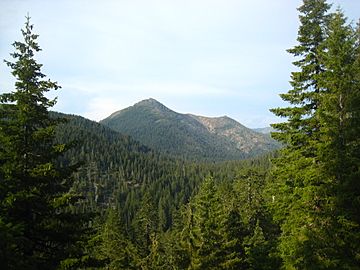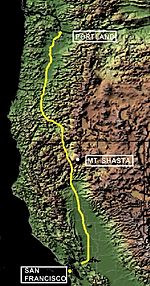Siskiyou Mountains facts for kids
Quick facts for kids Siskiyou Mountains |
|
|---|---|

Forest in the Siskiyou Mountains in California
|
|
| Highest point | |
| Peak | Mount Ashland |
| Elevation | 7,536 ft (2,297 m) |
| Geography | |
| Country | United States |
| Range coordinates | 41°49′59″N 123°40′04″W / 41.83306°N 123.66778°W |
The Siskiyou Mountains are a beautiful mountain range in the United States. You can find them in northwestern California and southwestern Oregon. These mountains are part of a larger group called the Klamath Mountains. They stretch for about 100 miles (160 km), curving from east of Crescent City, California, all the way into Josephine and Jackson counties in Oregon.
The Siskiyou Mountains act like a natural wall. They separate the water flowing into the Klamath River to the south from the water flowing into the Rogue River to the north. Even though they aren't the tallest mountains in the Klamath range, they get a lot of rain and snow. This is because they are so close to the Pacific Ocean. All this moisture helps amazing, thick forests grow here.
The mountains are home to many different kinds of plants and animals, which is called biodiversity. Some areas get over 100 inches (2,500 mm) of rain in winter, while others are drier. Because the Siskiyous run both north-south and east-west, you can find plants from the coast, like Coast Redwood trees, and plants from colder, higher places, like Alaska Yellow-Cedar. Much of this special area is protected within the Rogue River – Siskiyou and Klamath national forests. The famous Pacific Crest Trail also runs along part of the mountains.
Contents
What Does "Siskiyou" Mean?
The name Siskiyou has a few interesting stories behind it, and no one is completely sure which one is true!
A Horse's Tale
One idea is that "Siskiyou" comes from a word in the Chinook Jargon language, which means "bob-tailed horse." A historian named Richard Mackie says it was a Cree word for a horse with a short tail. In 1829, a bob-tailed horse died during a trip led by Alexander Roderick McLeod over a mountain pass. This pass was later named Siskiyou Pass. The Cree people were part of McLeod's team from the Hudson's Bay Company, and they had traveled all the way from eastern Canada.
Six Stones Story
Another story, told in 1852, says the name comes from the French words Six Cailloux, meaning "six stones." In 1832, a group of Hudson's Bay Company trappers led by Michel Laframboise crossed the Umpqua River. They named the crossing "Six Cailloux" because there were six large stones in the river. Some people believe this name was then used for the Siskiyou region by another trapper, Stephen Meek, for a crossing on the Klamath River. There are also some who think the name came from a local Native American tribe.
History of the Siskiyou Mountains
Long ago, before 1850, Native American people who spoke the Athapaskan Language lived along the Rogue River. They often spent their winters in settlements by the river and their summers exploring the mountains.
Early Explorers Arrive
The first explorers to reach this area usually came by ship from the coast. In 1775, Spanish lieutenant Bruno de Heceta explored the Northwest. Later, in the 1790s, other explorers like Captain George Vancouver and Robert Gray followed. Early land expeditions from the west avoided the Oregon-California border area. The first land explorers arrived in the 1820s with the North West Company, followed by the Hudson's Bay Company.
The Siskiyou Trail was a very important path. It stretched from California's Central Valley through the Siskiyou Mountains to Oregon's Willamette Valley. This trail was originally based on old Native American footpaths that followed river valleys. In the 1820s, it was the shortest way to travel between the early settlements in California and Oregon.
New Settlers and Gold Rush
As more people moved to the area, there were more disagreements with the Native Americans. In the 1850s, after the Donation Land Claim Act, many miners came looking for gold. Thousands of miners rushed in when they found profitable gold claims. New towns grew, and Jackson County was created in 1853.
The sudden increase in white settlers caused problems with the local Native Americans. This led to the Rogue River Wars in 1855, which ended in 1856.
Growing Industries and Transport
To support the new population, better roads and services were needed. By 1859, the old trail became a toll road. A telegraph line was built over the mountain pass in 1864. By the late 1870s, the first private lumber mills started operating in the mountains. Farmers began planting fruit orchards in 1885. The Southern Pacific Railroad was finished over Siskiyou Summit in 1887. These new railroads helped towns like Medford grow.
Industry Continues to Grow
The Klamath Lake Railroad Company built a railroad into Pokegama between 1900 and 1903. This railroad became very important for the lumber industry. It was bought by Weyerhaeuser in 1905. Watering projects that started in the late 1800s caused a big increase in the fruit orchard business. At first, apples were the main crop. But around 1900, apple diseases reduced the harvest, and pears started to become more popular. By 1910, pears were the main fruit grown in the region. In 1927, the main government office for Jackson County moved to Medford, which had become much larger than Jacksonville.
Geography of the Siskiyou Mountains
The highest points in the Siskiyou Mountains are mostly in Oregon. These include Mount Ashland (7,533 feet or 2,296 meters), Dutchman Peak (7,410 feet or 2,258 meters), Siskiyou Peak (7,147 feet or 2,178 meters), and Wagner Butte (7,140 feet or 2,176 meters). In the California part of the range, the highest peak is Preston Peak (7,309 feet or 2,228 meters). The main rivers that collect water from these mountains are the Rogue and Klamath Rivers.
Siskiyou Summit: A Mountain Pass
Interstate 5 crosses through the Siskiyou Mountains at a place called Siskiyou Summit. This pass is just north of the Oregon-California border, near Ashland, Oregon. Siskiyou Summit is the highest point on Interstate 5, at 4,310 feet (1,314 meters) above sea level.
This pass can be one of the most challenging parts of the Interstate highway system. The California side has a gentler slope. But on the Oregon side, the freeway climbs or drops about 2,300 feet (700 meters) in only about 7 miles (11 km)! The pass also has several sharp curves. In winter, it often gets snow, ice, and thick fog. Because of these tough conditions, the highway is usually closed a few times each winter by transportation officials for safety. The speed limit is 55 mph (89 km/h), but larger trucks must go slower.
Climate in the Siskiyou Mountains
The weather in the Siskiyou Mountains changes a lot from the coast to the inland areas. Generally, places closer to the coast have milder temperatures and more rain. The mountains create a big difference between the coastal and inland climates. The inland areas tend to be drier and warmer in the summer. The eastern slopes of the mountains have a climate similar to the inland areas.
The coast usually gets about 60 inches (1,500 mm) of rain each year. This amount increases to about 100 inches (2,500 mm) at the highest peaks. The drier eastern areas receive around 30 inches (760 mm) annually. Most of the rain falls in winter, and the least in summer. At lower elevations, especially in summer, fogs also provide extra moisture. Most of the water at lower elevations comes as rain, but at higher elevations, snow is a major source of water.
Temperatures usually stay similar along the coast because the ocean has a big effect. The average yearly temperature in the low areas is about 11 to 11.5 degrees Celsius (52 to 53 degrees Fahrenheit). Higher in the mountains and further east, temperatures can range from just above freezing to highs around 21 to 23 degrees Celsius (70 to 73 degrees Fahrenheit).
Ecology: Plants and Animals
The Siskiyou Mountains have a huge variety of living things, which is called biodiversity. This includes vast forests. The types of forests change depending on how high up you are and where they are located. They are mainly divided into mixed evergreen forests, montane forests (mountain forests), and subalpine forests (forests just below the tree line).
Flora: Plants and Trees

Different types of trees grow in these different forest areas. For example, Coast Douglas-fir trees grow in both mixed evergreen and montane forests. Lawson's cypress (also known as Port Orford cedar) grows throughout the western part of the range. California white fir trees grow in montane and subalpine forests above 4,000 feet (1,200 meters). In the montane forest, where there is snow, you can also find sugar pine trees.
The subalpine forests, found above 5,000 feet (1,500 meters), include mountain hemlock and Shasta red fir, along with Douglas-fir. Ponderosa pine trees are most common on steep, south-facing slopes in montane forests. They also grow with California black oak and in mixed evergreen forests. Rare Pacific yew trees grow at low elevations or higher up near water sources. Other cone-bearing trees include the weeping spruce, which is a special tree found only in this area, and coast redwood trees.
Besides cone-bearing trees, many different kinds of broadleaf trees also grow here. The largest California black oak tree known is found in the Siskiyou Mountains. You can also find some blue oak trees, even though they are usually found in other areas.
Sometimes, plants that are not native to the area, called invasive species, become a problem. Some of these include yellow starthistle and scotch broom. Yellow starthistle has only become a problem in the last 20 years. It doesn't provide much food or shelter for local animals and can grow faster than many native plants. Purple loosestrife is another invasive plant that harms waterways.
Fauna: Animals and Their Life Cycles
The Siskiyou Mountains are home to a wide variety of animals, including many amphibians, reptiles, and birds. Many of the amphibians and reptiles are endemic, meaning they are found only in this region. For example, the Siskiyou Mountains salamander and the Scott Bar salamander live here. The many different habitats in the mountains mean there are lots of bird species. However, many birds leave the area after their breeding season. This includes the endangered spotted owl, which lives in forests up to 5,800 feet (1,768 meters). Endangered salmon also live in the Rogue and Klamath rivers.
Mammals in the area include small rodents, deer, elk, bears, and coyotes. Medium-sized mammals like red fox, gray fox, and weasel also live here. Another rare animal is the fisher, a medium-sized predator that lives in very old forests.
Protected Areas
The Siskiyou Mountains have several areas that are protected by the government. The Oregon Caves National Monument and Preserve protects 4,558 acres (1,845 km²) in the northern part of the range, south of Grants Pass, Oregon. The Cascade–Siskiyou National Monument protects 52,940 acres (21,424 ha) where the Siskiyou and Cascade ranges meet.
There are also three special wilderness areas in the range, in both Oregon and California. These are:
- The Red Buttes Wilderness, which protects 19,940 acres (8,070 ha).
- The Kalmiopsis Wilderness, protecting 179,755 acres (72,744 ha).
- The Siskiyou Wilderness, protecting 153,432 acres (62,092 ha).
Images for kids






